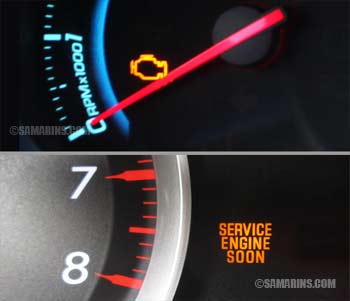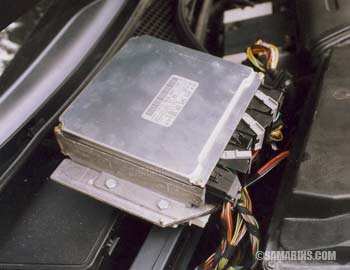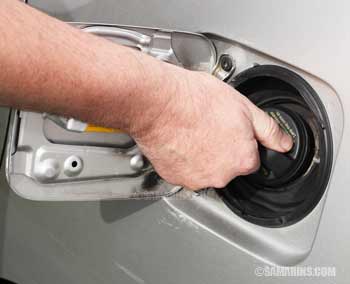why is the check engine light showing Suzuki Honda corolla
Updated: January 09, 2019
It's what almost every motorist has to go through once in a while: the Check Engine or Service Engine Soon light. If this warning light stays on, it means that your vehicle's computer has detected a problem that can affect your vehicle's fuel economy and emissions.

Check Engine or Malfunction indicator light (MIL)
|
Let's explore your options on how to deal with it. First, shortly how it works. Your car has a computer (in the photo) that controls the powertrain (engine and transmission). This computer is called Powertrain Control Module (PCM). It works by monitoring signals from various sensors and adjusting the engine and transmission performance for better fuel economy and lower emissions.
This computer has a self-testing capability (called ON-Board Diagnostic or OBD-II). When it detects a fault with one of the systems or sensors, it turns on the Check Engine light on your dash. At the same time, it stores the fault code in its memory. There are hundreds of possible codes, but some are more common than others.
To diagnose the problem, your mechanic will have to connect a scan tool to your vehicle and retrieve the code from the computer.
This computer has a self-testing capability (called ON-Board Diagnostic or OBD-II). When it detects a fault with one of the systems or sensors, it turns on the Check Engine light on your dash. At the same time, it stores the fault code in its memory. There are hundreds of possible codes, but some are more common than others.
To diagnose the problem, your mechanic will have to connect a scan tool to your vehicle and retrieve the code from the computer.

The engine computer or Powertrain Control Module (PCM)
|
The code itself doesn't tell exactly what part is defective, it only tells what system doesn't work properly or what parameter is off. Your mechanic will have to do further testing to find the defective part. Once the problem is repaired, your mechanic will reset the Check Engine light.
Of course, the repair could be costly unless it's covered by the warranty. Is there any other way reset the Check Engine light? Is it safe to drive with the Check engine light on? What parts could be covered by the warranty? Is it possible to repair the problem DIY? We will try to answer these and other questions in this article.
Of course, the repair could be costly unless it's covered by the warranty. Is there any other way reset the Check Engine light? Is it safe to drive with the Check engine light on? What parts could be covered by the warranty? Is it possible to repair the problem DIY? We will try to answer these and other questions in this article.
What needs to be checked first

Check if your gas cap is tight
|
If you check your owner's manual, it will probably tell you to check if the gas cap is tight. This is because the Check Engine light may come on if your gas cap is not closed properly. Usually, it happens soon after a fill-up at a gas station. If you do find that the gas cap wasn't tight, close it properly and if there are no other problems, the Check Engine light will reset by itself after a day or two of driving. If the gas cap is tight, there is another problem.
If the Check Engine light came on after your car has been serviced, take it back to the repair shop and ask them to re-check it. If you are comfortable doing basic checks under the hood, check if you have enough oil in the engine (see how to check the oil level), see if the battery terminals are tight, if the air filter box is closed properly or if anything appears to be loose or disconnected under the hood. You can find a map of your engine compartment and instructions on how to check the oil level in the Maintenance section of your car's owner's manual.
Another simple problem that can cause the light to come on is the driver's floor mat. If it doesn't fit or is not secured properly, it might accidentally push the gas pedal when pressing the brakes. See the example of a wrong floor mat installed. In many modern cars, there is a safety feature that cuts power if the brake and gas pedals are pressed at the same time. A floor mat must be secured and fit properly.
If the Check Engine light came on after your car has been serviced, take it back to the repair shop and ask them to re-check it. If you are comfortable doing basic checks under the hood, check if you have enough oil in the engine (see how to check the oil level), see if the battery terminals are tight, if the air filter box is closed properly or if anything appears to be loose or disconnected under the hood. You can find a map of your engine compartment and instructions on how to check the oil level in the Maintenance section of your car's owner's manual.
Another simple problem that can cause the light to come on is the driver's floor mat. If it doesn't fit or is not secured properly, it might accidentally push the gas pedal when pressing the brakes. See the example of a wrong floor mat installed. In many modern cars, there is a safety feature that cuts power if the brake and gas pedals are pressed at the same time. A floor mat must be secured and fit properly.
Is it safe to drive with the "Check Engine" light on?
It really depends on what the problem is. It could be something minor, like a loose connector or low battery voltage, but it also could be a more serious issue that could cause more damage to your vehicle. In worse cases, a car may stall or lose power. We recommend having your car checked out as soon as possible to be on the safe side. If the Check Engine light is blinking repeatedly, it means that the engine computer has detected that your engine is misfiring, which means that some of the engine cylinders are not working properly. Driving with a misfiring engine could damage your catalytic converter, which is a very expensive part. Check your owner's manual, it will probably suggest to reduce power and have your vehicle serviced immediately by your authorized dealer. Read more about symptoms of a misfiring engine: Code P030X - cylinder misfire.
What are the common problems that can cause the Check Engine light?
In older cars, it was typically something like a bad oxygen sensor, worn-out spark plugs or ignition wires. Modern cars have a lot more electronics, which means, many other things could go wrong too. It's practically impossible to find the problem without at least scanning the vehicle and retrieving the stored code(s). On the other hand, once you know the code that caused your Check Engine light, it's not that difficult to do some research and find out common problems for your car's make and model that can cause the particular code. From our experience we can name several more frequent problems that can cause the Check Engine light in many cars: vacuum leaks, issues with a mass airflow sensor, failed ignition coils, leaking purge valve or vent valve, failed air-fuel ratio sensor, bad EGR valve and a failed catalytic converter.
Comments
Post a Comment